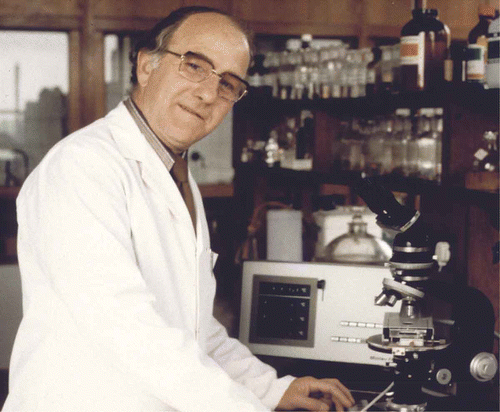The work of some scientists have become immortalised after they die, but for some, their work leads to immortalisation during their lifetimes, this was so for George Gray.
A seminal scientific contribution that engenders a paradigm shift in the way in which we view the world may be measured by the changes induced in the methods in which scientists and engineers prosecute their research and development programmes, and/or the changes to common words and phrases used in languages across the world. The advance in the discovery and design of new liquid crystals masterminded by George Gray in 1972 led directly to the creation of the current liquid crystal display (LCD) industry and the introduction of new expressions to all languages, for example, LCD and LCD-TV, thereby fulfilling both of the above criteria, and making his work undying.
George Gray's systematic research into the synthesis and characterisation of liquid crystals, which had been ongoing since the early 1950s, led to the creation of the first chemically and photochemically stable, colourless, room temperature nematogenic materials with positive dielectric anisotropy, the cyano-biphenyls, which were suitable for use in the twisted nematic LCD (TNLCD) device. In the process of generating new materials with novel functionalities for display devices, George also created a family of stable nematic and smectic liquid crystals suitable for physical and chemical investigations. His work at the time, therefore, underpinned much of the ensuing fundamental research in the fledgling subject of liquid crystals, and his materials became the subjects of several thousand articles by other scientists.
Ultimately, George's cyano-biphenyl liquid crystals found their way into watches, calculators and multiplexed display devices. They also acted as templates for the development of nematogens for super-twisted nematic (STN) displays, low conductivity materials for thin-film-transistor (TFT)-LCDs, and non-steroidal cholestrogens for surface thermographic applications. In the mid-1980s George Gray and Ken Toyne, along with scientists at Merck became the first researchers to develop nematic liquid crystals with negative dielectric anisotropies via Suzuki boronic acid coupling reactions. This technology revolutionised the design and advances in materials and made LCD-TV possible via the development of vertically aligned nematic (VAN) displays.
Over 20 years at Hull University, from 1970 to 1990, George Gray guided research in the synthesis, characterisation and elucidation of property–structure correlations of liquid crystals. His contributions to research in self-assembling/organising systems, not only spanned nematic and cholesteric technologies, but also the newer chiral, Blue Phase, smectic, ferroelectric and polymeric technologies. He also developed new synthetic methods, which could be used to engineer materials, so that the resulting compounds had precise physical and functional properties. This is truly ‘nano-engineering’. Over this period, George Gray's research group at Hull produced several thousand new liquid crystals, thereby making George the world's premier synthesiser of new liquid crystals, with virtually every home and place of work in the developed world using materials that he invented.
George will always be remembered from the seminal discovery of cyano-biphenyls as though this was a singularity in time and the beginning of a new age of information transfer, however, there is more to it than this. After completion of his undergraduate degree in Chemistry, from the University of Glasgow, he moved to the University College of London at Hull in 1946 to take up the post of Assistant Lecturer. Under the guidance of Sir Brynmor Jones he studied for his PhD in the new topic of liquid crystals. After graduation, 8 years later, he spent the next decade laying down the rules on the design and preparation of liquid crystals formed by organic compounds, culminating with the publication, in 1962 at the age of 38, of the first English textbook on the subject entitled, ‘Molecular Structure and the Properties of Liquid Crystals’. George achieved this without a laboratory full of researchers, mostly working on his own. By the mid-1960s, George found it difficult to find support for his work on liquid crystals, and so with provision from the Medical Research Council and Reckitt and Sons Ltd., a health and consumer products company, he moved his research into the closely related study of the chemistry of the cell walls of bacteria. In particular, he studied lipopolysaccharides of the Gram-negative organism Pseudomonus seruginosa, another form of liquid crystal research! Even then, during this period he was still finding ways to derivatise biphenyls and terphenyls, and when success came and he had the opportunity to ask the Science Research Council in the UK for support for his research he was surprised to be told to ‘find a chemist to work with’!
George's views on science and his research can be found in a video interview with Sir Harry Kroto at vega.org.uk. George was once asked what advice would he give to young up-and-coming scientists, and he said, ‘Science is a difficult field that demands great effort and dedication, but if you are willing to make the effort, there is much to gain.’
But what of George the person? A number of emails I have received over the past few weeks have highlighted his supportive nature to the research of the sender, a willingness to listen and to suggest other possible routes to take, the importance of talking with scientists of other disciplines, modesty and the lack of arrogance, easy approach towards teaching and nurturing young students, and above all humour and patience. He was most proud of being elected by his peers to become a Fellow of the Royal Society, and his most unusual recognition was to have a Hull Trains ‘Pioneer-Class train’, which regularly ran from Hull to London, named after him. In a strange coincidence George's train ferried my York researchers back from London after the explosions in 2007, when no other trains ran south of Peterborough to London! Personally, I learned from George
Science is a way to teach how something gets to be known, what extent things are known (for nothing is known absolutely), how to handle doubt and uncertainty, what rules of evidence are, how to think about things so that judgements can be made, how to distinguish truth from fraud, and from show.
Richard Feynman
So the giants pass away one after another. Each time one realizes that they are irreplaceable.
Sven Lagerwall
George Gray was born in Denny, Scotland on September 4, 1926, his father was a pharmacist, a scientist and a botanist, and influenced by his father, George developed an interest in chemistry. He gained his doctorate in 1954 for Hull University College of London, and he became a Senior Lecturer in 1960, Reader in Chemistry in 1964, and at the age of 52, Professor of Chemistry in 1978 at Hull. His contributions to liquid crystals over 40 years of research have been recognised in many ways as follows: the Queens Award for Technological Achievement, the Rank Prize for Optoelectronics, Leverhulme Gold Medal, and the Kyoto Prize. He was made a Fellow of the Royal Society London (FRS), a Fellow of the Royal Society of Edinburgh, a Member of the Royal Irish Academy and Commander of the British Empire (CBE). He has been awarded seven Honorary Doctorates, published over 350 research papers and patents and has written several textbooks. His research at Hull brought recognition to the University in the Queens Award for Technological Achievement in 1979, the first award of its type to a university in the UK, and in November 2005 a Historical Chemical Landmark was awarded to the University of Hull by the Royal Society of Chemistry to commemorate over 50 years of liquid crystal research.
John W. Goodby
Department of Chemistry, University of York
Heslington, York
Email: [email protected]

